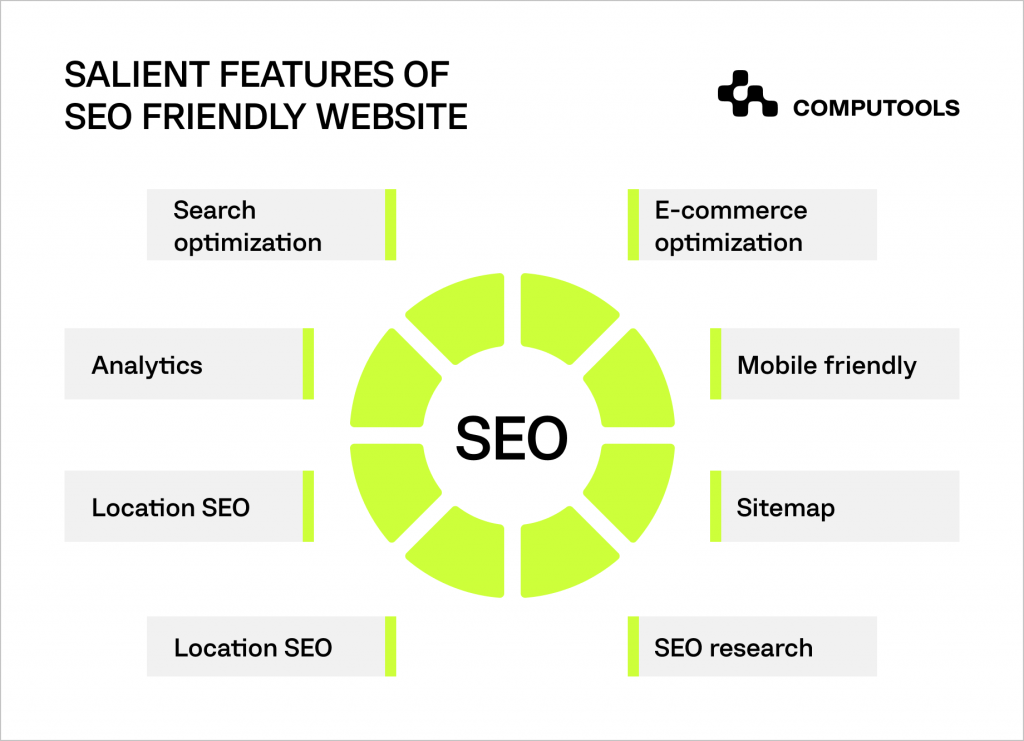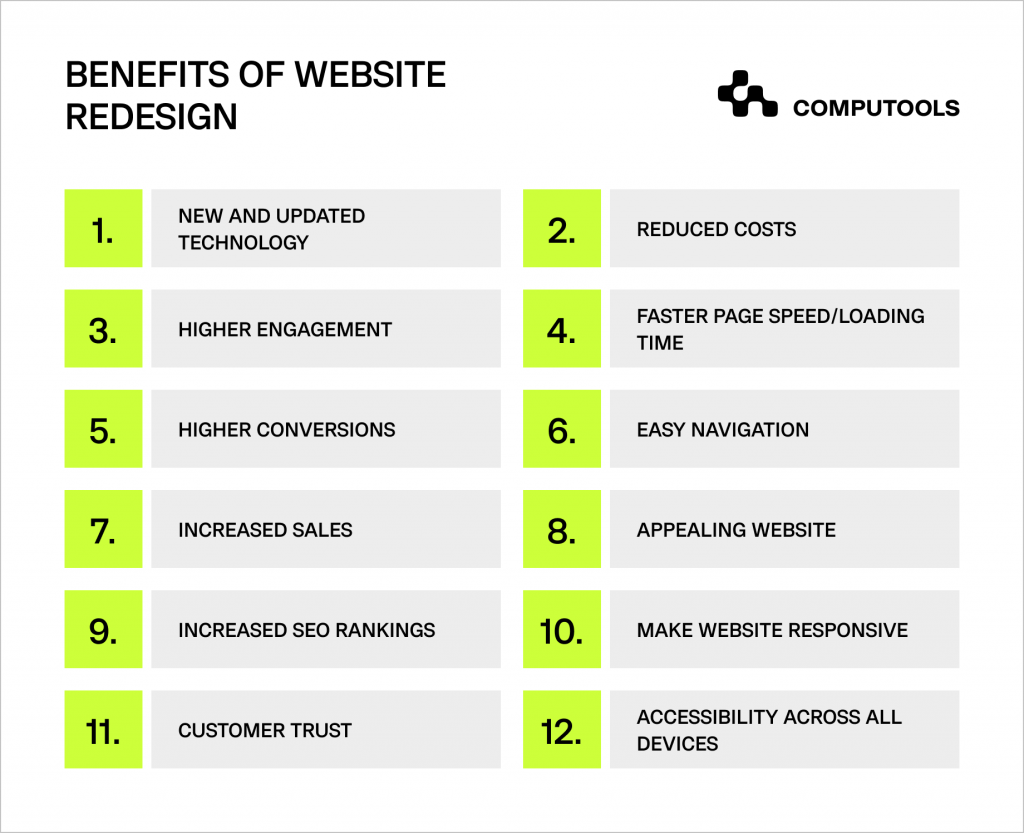Don’t judge a book by its cover, they say, but let’s be real – we all do. In the business world, a company’s website is its cover. Websites not only showcase products and solutions but also serve as tireless sales representatives, maintaining consistent branding and building a company’s reputation. They do everything, everywhere, all at once, as it were. That’s why a poorly performing website can be very devastating to any business owner.
As Forbes states, the majority of users form an opinion about a website within the first 0.05 seconds. This highlights the importance of a high-quality website featuring an engaging design, intuitive navigation, and valuable information, providing essential solutions for its visitors.
If you’ve ever wondered how to increase conversion rates, boost the online visibility of your brand, or get more calls and orders from potential customers, it’s time to consider a professional website redesign.
As reported by Business 2 Community, the typical lifespan of a website ranges from 1.5 to 2.5 years. This period aligns with the pace of evolving design trends and advancing technology, ensuring that a redesign remains relevant and competitive. Nonetheless, it’s important to note that this time frame serves as a general benchmark, and you should assess what best suits your business.
So, why is website redesign important?. And what are the signs pointing to the need for changes? Let’s find out!
15 Signs It’s Time for a Business Website Redesign
1. Your site has a high bounce rate
What is a bounce rate? It’s a metric that refers to the percentage of visitors who leave a website after viewing only one page, without interacting further with the site. In other words, these visitors ‘bounce’ away without visiting additional pages or taking any actions, such as clicking on links, filling out forms or making purchases.
According to the research of HubSpot, the average bounce rate falls between 26% and 70%, with the typical range typically being 19% to 40%. If visitors are leaving your site shortly after arriving, it could be a sign that your content, layout or user experience needs improvement.
Redesigning your website with a focus on up-to-date content and an appealing design can significantly increase low conversions.
2. Your website navigation is not user-friendly
Difficult website navigation means confusing menus, unclear navigation paths or a cluttered layout that frustrates visitors, leading to poor engagement.
If your website navigation feels like a maze, it’s time to consider a redesign to streamline the user journey and keep visitors coming back for more. This means offering relevant information and avoiding overwhelming users with unnecessary details about your product or service.
Ultimately, redesign revolves around anticipating the user’s needs, understanding when and how they need information and simplifying the process at every stage.
3. Your website lacks SEO optimisation
If your business doesn’t have an SEO-friendly website, it might be missing out on crucial online visibility. An optimised website ensures that search engines can easily crawl and index your content, making it more likely to appear in relevant search results.
Without proper optimisation, customers and search engines might struggle to find your site, leading to decreased traffic. If your site isn’t using its SEO potential, it could be time for a redesign to incorporate essential SEO elements and boost your online presence.

4. Your website takes a long time to load
One of the primary reasons your website may need a redesign is slow website speed. Portent’s research showed that for every extra second of load time within the initial 0–5 seconds, website conversion rates decrease by an average of 4.42%.
In today’s fast-paced digital world, users expect instant access to information. A website redesign can optimise loading times, ensuring a seamless and efficient user experience, thereby enhancing visitor satisfaction and increasing the chances of conversions.
5. The content on your site is outdated
Outdated content can impact your site’s credibility and relevance, potentially turning away visitors seeking up-to-date information. Visitors might assume your business is stagnant or not actively engaged.
Regularly updating your content is crucial to staying current, attracting visitors and retaining a loyal audience. A redesign can help refresh your website with valuable, and engaging content, ensuring your visitors find the information they seek, thereby improving your site’s effectiveness and user experience.
6. You receive a lot of questions from your website visitors
If your inbox is flooded with questions from website visitors, it’s a clear sign that your site might benefit from a redesign. An effective redesign can strategically place call-to-action buttons, guiding visitors to essential information and reducing their need to ask basic questions. Streamlining your site’s layout and content can provide instant answers, ultimately reducing enquiries.
7. Your website lacks a responsive design
According to research by Exploding Topics the majority of global website traffic, specifically 55%, originates from mobile devices, indicating that most users access websites via their smartphones rather than desktop computers or tablets.
Not having a mobile-friendly website, you risk missing out on a significant portion of your potential audience who prefer to browse, shop and interact with businesses on their mobile devices. A website redesign with a focus on mobile responsiveness can help you reach a broader audience, improving your overall online performance.
8. Your business is rebranding
Updating your website is essential to reflect the new brand identity cohesively. A redesigned website ensures consistency, aligning the visual elements with your updated brand guidelines, messaging and values. This transformation strengthens your brand’s credibility, leaving a lasting impression on your visitors and potential customers. Stay ahead in the competitive market by aligning your online presence with your revamped brand image through a strategic business website redesign.
9. Your competitors have better websites
There’s no shame in learning from your competitors – even more, it’s an essential aspect of conducting market research and adopting best business practices. If your website falls behind your industry peers, potential customers might prefer their services to yours. A redesign is crucial to level the playing field. It ensures your online presence not only matches but surpasses competitors, attracting and retaining valuable customers.
10. Your website contains useless features
If your website is cluttered with irrelevant or redundant features, it might confuse visitors and deter them from engaging with your content. Overly complex animations slow down the site’s loading speed, intrusive pop-ups disrupt the user’s browsing, excessive social media widgets clutter the interface, and so on.
Simplifying the user experience can enhance clarity, making it easier for users to navigate and find what they’re looking for. A redesign focused on streamlining your site’s functionality can significantly improve user satisfaction.
11. Your website has security problems
Cybersecurity threats are constantly evolving, and your website might lack the necessary protection against modern online risks. Security breaches can damage your reputation, compromise customer data and adversely impact your business. A redesigned website can implement robust security measures, ensuring a safe and trustworthy online environment for both your business and your visitors.
12. Your website has non-functional hyperlinks
Non-functional links, also known as broken links, are web links that no longer lead to their intended destinations. These can occur due to various reasons, such as changes in the website’s structure, expired content, or typos in the URL.
When visitors encounter broken links, they may perceive the website as outdated, unprofessional or unreliable. Therefore, if your website contains broken links, it’s a sign that a redesign is necessary to ensure seamless navigation.
13. Your website has an outdated design
Today, users have grown accustomed to websites with modern, human-centred design elements that offer an intuitive and pleasing browsing experience. Poor UX can deter visitors and harm your brand’s credibility.
Investing in UX/UI design services can play a major role in improving your website’s aesthetics and functionality. A well-crafted UX not only enhances the overall user experience but also contributes to increased engagement and, ultimately, improved profitability.
14. Your website is difficult to update
An outdated or complex content management system can make routine updates a time-consuming and frustrating process. If your site was built using obsolete platforms or software, making updates becomes complicated. Additionally, complex coding structures can pose a hurdle, requiring significant effort to modify, as well as a lack of a Content Management System (CMS) further worsening the issue, making routine updates dependent on technical expertise.
A website should be user-friendly, not only for visitors but also for those managing its content. Improving your website’s update process through a redesign can not only save you time but also ensure that your site remains fresh and up to date with ease.
15. Your business is ready to develop
As your business grows and evolves, your website should keep pace. If you find that your company is expanding, offering new products or services or entering new markets, it’s a clear sign that your website may need a redesign. Your website should reflect your current business offerings and target audience.
A website redesign can provide a fresh canvas to align your online presence with your new goals and objectives. Additionally, as your customer base grows, you might need to incorporate new features to accommodate increased traffic and customer demands.
Learn more how to work with your conversion rates with website redesign.
Contact us →Key Benefits of Website Redesign
So, what does website redesign mean? At its essence, redesign involves a comprehensive update of the website’s code and appearance, modifying various core parameters to enhance functionality, aesthetics and user experience.
The benefits of business website redesign are various:
• Effective UX helps businesses to increase profit
• A visually appealing and user-friendly website fosters a positive perception of your brand
• A mobile-first web design approach ensures your website functions flawlessly across devices
• SEO-optimised content improves site speed, attracting more organic traffic
• A technologically advanced website sets you apart from competitors
A business website redesign goes beyond aesthetics: it’s a strategic initiative that transforms your online presence, driving user engagement, boosting conversions and ultimately propelling your business toward greater success.

Is It Time to Redesign Your Website?
When you put your effort and money into something, you obviously want it to live long and happily. Unfortunately, this doesn’t always apply to business websites. Recognising that your old design isn’t effective anymore is a key step to a successful marketing strategy. If the signs mentioned above resonate with you, it might be time for a redesign.
Finding a dependable IT partner with subject matter expertise in your business niche is crucial for maximising your website’s potential. Redesigning becomes a no-brainer when collaborating with seasoned professionals who understand and address your specific needs.
Pay close attention to your website. It’s just like your body – it signals when something isn’t right.
If you’re uncertain about your next steps, don’t hesitate to get in touch with us at info@computools.com. We’re here to help.









Computools was selected through an RFP process. They were shortlisted and selected from between 5 other suppliers. Computools has worked thoroughly and timely to solve all security issues and launch as agreed. Their expertise is impressive.